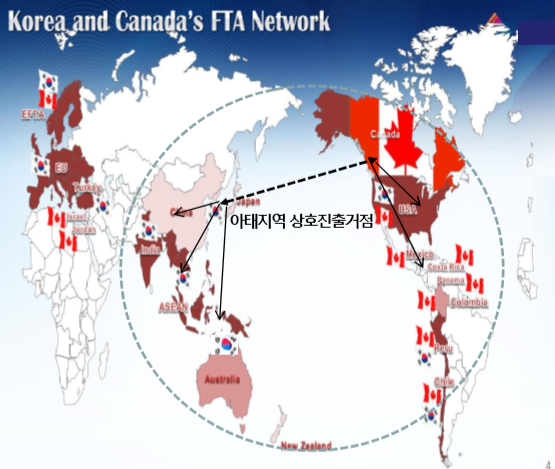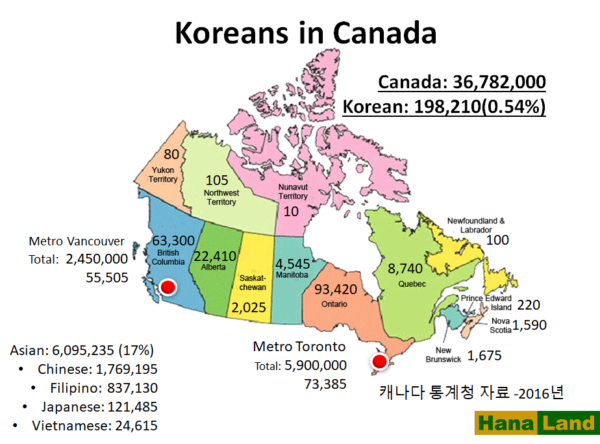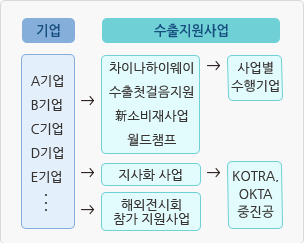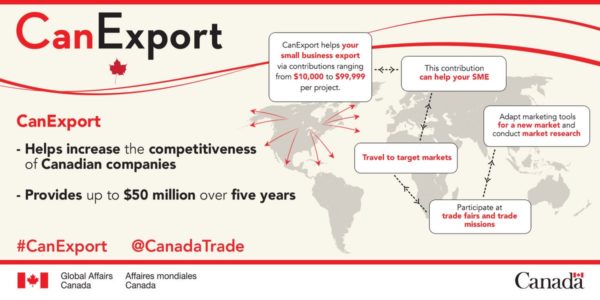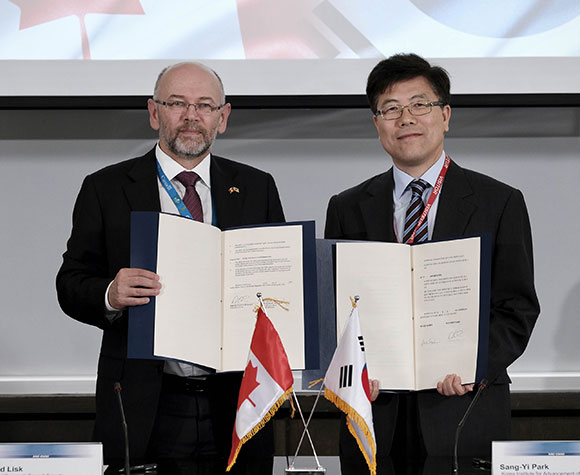Canada-Korea Import/ Export Accelerator
- Import/Export
- R&D, Foods, Cosmetics, Medical Device, Toys, Eco Friendly Product, Beauty
- SFCR Licence: CAS-2019-01438 – until 2023
- Safe Food for Canadians Regulations
- Preventive Control Plan of CFIA
- Canada Buyer
- 대구 Onestop 수출상담 – KOTRA
- 서울 LifeStyle 수출상담- KOTRA
- 전주수출상담회 – KOTRA
- 서울 Innotech Korea – KOTRA
- 제주 수출상담회 – OKTA
- Canada-Korea R&D Project
- Canada-Korea Collaborative Industrial & Development Program
- Going Global-Innovation
- Eureka International R&D Network
- Canada – NRC, IRAP
- Korea – KIAT, GAC
- 전시회 참가
- K-Beauty/Wellness
- Seoul Food 2022
- 국제 수산식품 전시회 2022
- The Golf Show
- KOTRA Vancouver & Korea Tourism Organization
- Health Foods
- Cosmetics
- Make Up
- K-Beauty/Wellness
- 수출 Voucher – ExportVoucher
- 내수/수출초보기업 전용 지사화사업
- KOTRA, 대한무역투자진흥공사
- GCC/EEN-Korea 글로벌 기술사업화
- SW 융합클러스터
- Global Market Development
- KOTRA, MSS, OKTA
- Korea Trade Delegation
- 벤처사업부, 중기청, 정부기관
Recent Projects
Projects
Canada-Korea Import/Export
R&D, Foods, Eco Friend Products, Beauty etc한-캐 중소기업 수출입

시장조사, 타당성조사, 홍보물 제작, 바이어 미팅/초청, 현지현장 연수, 샘플구입 및 발송, 해외인증, 수입/수출
Canada-Korea R&D Project
Canada (National Research Council Canada) & Korea Institute for Advancement of TechnologyCanada/Korea Buyer
KOTRA, OKTA캐나다 수출 바이어

- 2018 서울 InnoTech Korea
- 2018 전주 수출상담회
- 2018 제주 수출상담회
Export Voucher
KOTRA, MSS, SBC, OKTA수출 바우처

개발.제작, 전략 컨설팅, 홍보.광고/온.오프라인 마케팅, 시장조사.정보, 바이어 매칭, 전시회, 상담회, 계약체결, 해외진출등
K-Beauty/Wellness
KOTRA, Korea Tourism OrganizationK뷰티/웰니스
K-Beauty & Wellness in Vancouver, Canada
- Hosted by KOTRA Vancouver & Korea Tourism Organization
- 2019. 11.09
- JW Marriott Parq Hotel in Vancouver, BC Canada

GGI Program
To commercialize technology by pursuing collaborative internationa R&DThe Going Global Innovation Program
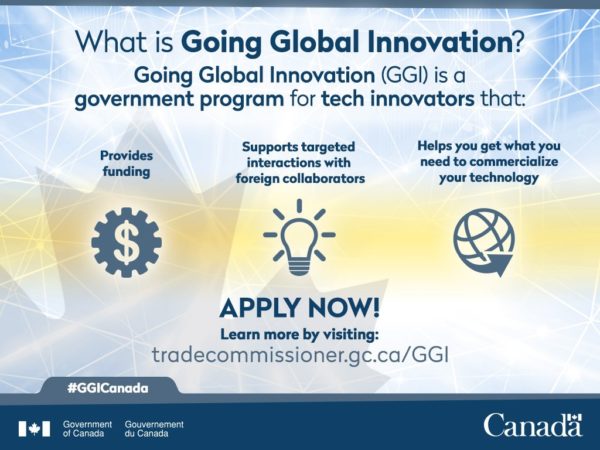
- GGI provides assistance by funding up to 75% of eligible expenses, up to a maximum of $75,000 for any approved project
Software Cluster
KIAT, GT, EEN-KoreaSW 융합 클러스터 산업

- SW융합 R&D 기반 인프라가 우수하고,
- SW융합 수요가 밀집된 5개 지역(부산센텀, 경기판교, 인천송도, 경북포항, 전북, 전주)간
- 협력강화 및 성과 활성화
Korea Trade Delegation
KOTRA, MSS, SBC, OKTA캐나다 시장개척단 바이어미팅

북미 시장개척단 바이어 미팅 및 현지 투어
Service Area
- 전략 컨설팅 – 캐나다 수출 전략, 해외진출 전략, 기업 중장기 성장전략, 법인 설립, 특허, 인증, 자문등
- 샘플구입 및 발송
- 바이어 미팅/초청 – 북미 전시회 참가, 국내개최 국제전시회 참가, 캐나다 바이어 매칭, 북미바이어 국내초청연결등
- 시장조사 – 캐나다 시장조사, 바이어 발굴, 경쟁사 동향조사, 해외시장 설명회 참가, 사업파트너 연결지원등
- 컨설팅 계약체결 – 계약서 작성 (지불조건 등), 결제관련 조건, 수출물류
- 홍보 – 기업 홍보 영문 동영상, 동영상 Subtitle, Google AdWords 마케팅, 온/오프라인 매장, TV, 신문등
- 개발.제작 – 영(불)어 웹사이트제작, 영(불)어 포장지/메뉴얼 번역등
- 홍보 – 기업 홍보 영문 동영상, 동영상 Subtitle, Google AdWords 마케팅, 온/오프라인 매장, TV, 신문등
- 현지현장 연수 – 한국회사 방문, 해외 마케팅용 동영상 제작참여, 영문 웹사이트 및 카탈로그 자문
- 해외인증 – 캐나다 으로 수출이 가능할 수 있는 해외인증 추진
- 해외진출 지원 – 캐나다 법인 진출 자문, 법인 설립
- 캐나다 진출 컨설팅 프로젝트
- KOTRA 밴쿠버와 수출초보기업 수입및 유통 마케팅 수행
- 대전TP 2021년 수출새싹지원사업수행
- KOTRA 밴쿠버 2020년 내수초보기업 전용 지사화사업 수행
- 충북 TP 2020년 수출새싹지원사업수행
- 충남 TP 2019년 수출새싹지원사업 수행
- 전남 TP 2019년 캐나다 밴쿠버 센터장 선정
- 강원 TP와 2018년 수출새싹지원사업 수행
- 수도권(서울) TP와 2018년 수출새싹지원 사업 수행
- 대전정보문화산업 진흥원과 2018년 SW 융합클러스터산업 수행
- KIAT와 2018년 GCC 산업 수행
- 중기청/벤처사업부/안산시청 주관 2017년 북미시장개척 바이어미팅 수행
- 캐나다 법인 설립및 유지비용: 년 450만원
-
- 초기 설립및 1년 유지비용 1회 – 450만원
- 유지비용 – 년 450만원
- 법인설립, 변호사, 회계사, 비용 포함
- 캐나다 시장및 타당성 조사
- KOTRA 주관 시장조사 수행
- 충북, 충남, 서울, 강원 TP & 한국무역협회 주관 시장조사 및 타당성조사 수행
- 대전정보문화산업진흥원 주관 시장조사 수행
- KIAT & 한국무역협회 주관 시장조사 수행
- 캐나다 바이어 매칭
- 중기청/경기벤처사업부/안산시 북미수출개척단
- 친환경
- 의류
- 식품/수산물
- 완구
- 의료기기
- R&D
- 각종 캐나다 전시회 참관을 통한 바이어 개척
- 전시회 참가

- 로드맵수립및 지원항목 코칭, 경영 멘토링
- 캐나다 수출전략
- 법인설립자문
- 지재권등록
- 투자유치지원
- 특허.인증
- 해외진출 전략컨설팅
- 기업중장기 성장전략 컨설팅
- 홍보.광고/온오프라인 마케팅-준비중
- TV, 신문, 잡지, SNS 홍보,
- 기업홍보동영상, 광고제작,
- Google Adword 마케팅,
- 온라인 쇼핑몰,
- 오프라인 매장 입점대행, 판촉
한국중소기업 수출/Business Development/벤처 자문
- 해외 비즈니스 센터장 – 전남TP
- 수출조보기업 마케팅 코디네이터 – KOTRA/부산TP
- 중소기업 컨설팅 전문위원 – 강원TP
- 세종 기업성장지원 전문가 – 세종TP
Why Choose Us
Canada-Korea Business Experience
-
-
- 28 year experience in Canada and USA
- MBA major in Entrepreneurship in Univ. of Victoria – the best program by Academy of Management in 2000 in the world
- Korea Branch Office in Korea S.
- Export consulting projects
- Various Team experiences – Consultant, Lawyer, Engineer, IPO experience, Sales, Business Development, Financial Officer etc
- Various Strategic Partners/Associations – OKTA, KOTRA, Small Business BC, TP, Winner’s Gate, Leader’s, Google AdWords, SMEs Consulting Platform, MRI, Korea Entrepreneurship Foundation etc
-
Why Canada and especially in BC
- Strong and stable economy: 10th largest in the world with a GDP of $1.7 trillion USD.
- Rich in natural resources: Boasts resources such as oil, gas, minerals, timber, and fresh water driving economic growth.
- Highly educated workforce: Attractive for businesses and investors due to its skilled and educated workforce.
- Access to North American market: Strategic location next to the largest market in the world.
- Stable political environment: Known for its strong commitment to democracy and human rights.
- Low inflation rate: Helps keep prices stable for both consumers and businesses.
- Growing technology sector: Home to many innovative companies and startups.
- High standard of living: Consistently ranked among the highest in the world.
- Friendly immigration policies: Skilled workers can move to Canada and start working easily.
- Abundant clean energy: Reduces dependence on fossil fuels and supports a sustainable economy.
- Total population: As of 2021, the estimated total population of Canada is approximately 38 million people.
- Area: Canada is the second largest country in the world by land area, covering approximately 9.98 million square kilometers.
- Greater Toronto Area (GTA):
- Korean population: Approximately 120,000
- Asian population (excluding Korean): Approximately 2.6 million
Greater Vancouver Area (GVA):
- Korean population: Approximately 40,000
- Asian population (excluding Korean): Approximately 1.2 million
- Agrifood market: Canada is a major producer and exporter of agrifood products, including grains, livestock, dairy products, fruits, and vegetables. In 2020, Canada’s agrifood exports to the world amounted to approximately $63 billion USD. The United States is Canada’s largest export market for agrifood products, accounting for over 60% of total exports.
- Seafood market: Canada is also a major producer and exporter of seafood, including fish, shellfish, and crustaceans. In 2020, Canada’s seafood exports to the world amounted to approximately $7 billion USD. The United States is also the largest export market for Canadian seafood, accounting for over 50% of total exports.
- In the agrifood market, Canada is one of the largest exporters globally, ranking among the top 10 countries in terms of exports. In the seafood market, Canada is also a major player, ranking among the top 20 countries in terms of exports.
Some key aspects of Canada’s clean technology sector include:
- Renewable energy: Canada is a major producer of hydropower, and is also investing in wind and solar energy to reduce its reliance on fossil fuels.
- Energy efficiency: Canadian companies are developing and implementing innovative technologies to improve energy efficiency in a variety of industries, including building construction, transportation, and manufacturing.
- Clean transportation: Canada is working to reduce its carbon emissions from transportation through investments in electric and hydrogen-powered vehicles, as well as alternative fuels and more efficient engines.
- Water and waste management: Canadian companies are developing technologies to conserve water and manage waste more sustainably, including water treatment systems and waste-to-energy facilities.
- Climate solutions: Canadian companies are also developing and implementing technologies to mitigate the effects of climate change, such as carbon capture and storage systems and climate-smart agriculture practices.
Canada’s clean technology sector is a growing industry, with an estimated value of over $50 billion USD in 2019. It offers a range of economic and environmental benefits, including job creation, reduced greenhouse gas emissions, and improved energy efficiency.
Some key aspects of Canada’s life sciences sector include:
- Biopharmaceuticals: Canada is home to a growing biopharmaceutical industry, which develops and produces drugs and therapies for a range of diseases and medical conditions.
- Medical devices: Canadian companies are developing and manufacturing innovative medical devices, such as diagnostic equipment and surgical instruments, to improve patient outcomes and reduce healthcare costs.
- Biotechnology: Canadian companies are using biotechnology to develop new treatments and products in areas such as regenerative medicine, genomics, and personalized medicine.
- Health informatics: Canadian companies are also using digital technologies to improve healthcare delivery and management, including telemedicine and health data analytics.
- Research and development: Canada is home to a thriving research and development community, with many universities and government research institutions focused on advancing the life sciences.
The life sciences sector is a significant contributor to the Canadian economy, with an estimated value of over $130 billion USD in 2020. It offers a range of economic and social benefits, including job creation, improved human health and wellbeing, and advancements in medical and scientific knowledge.
Some key aspects of Canada’s ocean technology sector include:
- Ocean observation and monitoring: Canadian companies and researchers are developing and implementing technologies to improve our understanding of the oceans, including ocean sensors, subsea vehicles, and satellite imagery.
- Marine renewable energy: Canadian companies are developing technologies to harness the energy of the oceans, including wave, tidal, and offshore wind power.
- Marine transportation: Canadian companies are developing technologies to improve the safety and efficiency of marine transportation, including autonomous ships and advanced navigation systems.
- Fisheries and aquaculture: Canadian companies are developing technologies to support sustainable fishing and aquaculture practices, including fish tracking systems and improved hatchery techniques.
- Ocean protection and management: Canadian companies and researchers are also developing technologies to protect and manage the oceans, including oil spill response systems and underwater mapping tools.
The ocean technology sector is a growing industry in Canada, with an estimated value of over $8 billion USD in 2020. It offers a range of economic and environmental benefits, including job creation, improved maritime safety, and increased understanding and protection of the world’s oceans.
Some key aspects of Canada’s LNG sector include:
- Natural gas reserves: Canada is home to significant reserves of natural gas, including large shale gas deposits in British Columbia and Alberta.
- LNG production: Canadian companies are developing and operating LNG production facilities, including liquefaction terminals, to process natural gas into LNG.
- LNG export: Canada is a growing LNG exporter, with LNG exports to Asia, Europe, and other regions.
- Environmental benefits: LNG is a cleaner burning fossil fuel than oil or coal, and its use can help to reduce greenhouse gas emissions and improve air quality.
- Economic benefits: The LNG sector provides significant economic benefits to Canada, including job creation and tax revenue, as well as increased energy security for Canada and its trading partners.
The LNG sector is a growing industry in Canada, with an estimated value of over $20 billion USD in 2020. Despite its environmental benefits, LNG development and production also faces significant environmental and social challenges, including the potential for greenhouse gas emissions, land use conflicts, and impacts on local communities and Indigenous peoples.
Some key aspects of Canada’s forestry sector include:
- Forest products: Canada produces a wide range of forest products, including wood products (such as lumber, pulp and paper), non-wood forest products (such as berries, medicinal plants, and mushrooms), and bioenergy products (such as wood pellets and biofuels).
- Sustainable forestry practices: Canadian companies are committed to sustainable forestry practices, including responsible forest management and conservation efforts to protect biodiversity and ecosystems.
- Forest-based innovation: Canadian companies and researchers are also exploring innovative uses of forests and forest products, including bioplastics, biocomposites, and new applications in the bioeconomy.
- Economic benefits: The forestry sector provides significant economic benefits to Canada, including job creation, tax revenue, and trade opportunities.
- Environmental benefits: Forests play a key role in mitigating climate change by removing and storing carbon, as well as providing habitat for a wide range of plant and animal species.
The forestry sector is a significant contributor to the Canadian economy, with an estimated value of over $50 billion USD in 2020. Despite its economic and environmental benefits, the forestry sector also faces significant challenges, including deforestation, unsustainable logging practices, and the impacts of climate change on forest ecosystems.
- Industry Overview: Canada has a thriving Interactive Games & Design industry with a strong presence in both game development and design.
- Market Size: The Interactive Games & Design market in Canada was valued at over CAD 4 billion in 2020 and is expected to grow at a CAGR of 6.5% from 2021 to 2026.
- Key Players: Some of the leading game development studios in Canada include EA Canada, Ubisoft Montreal, and Behaviour Interactive.
- Education & Training: There are several universities and colleges in Canada that offer programs in Interactive Games & Design, including the University of Waterloo, Sheridan College, and the National Animation and Design Centre.
- Government Support: The Canadian government provides support to the Interactive Games & Design industry through initiatives such as the Canada Media Fund and the Canadian Film or Video Production Tax Credit.
- Exports: Canada’s Interactive Games & Design industry is a significant exporter, with over 70% of its game development output being sold to international markets.
- Employment: The Interactive Games & Design industry employs over 12,000 people in Canada, with an average salary of around CAD 75,000.
- Future Prospects: The Interactive Games & Design industry in Canada is expected to continue to grow in the coming years, driven by the increasing popularity of video games, the growth of the virtual and augmented reality markets, and the increasing demand for interactive media.
- Industry Overview: Canada has a long-standing tradition in the Aerospace industry, with a strong focus on the development of aircraft, spacecraft, and satellite technologies.
- Market Size: The Aerospace market in Canada was valued at over CAD 28 billion in 2020 and is expected to grow at a CAGR of 3.5% from 2021 to 2026.
- Key Players: Some of the leading aerospace companies in Canada include Bombardier, CAE, and Magellan Aerospace.
- Education & Training: There are several universities and colleges in Canada that offer programs in Aerospace Engineering, including the University of Toronto, McGill University, and the École Polytechnique de Montréal.
- Government Support: The Canadian government provides support to the Aerospace industry through initiatives such as the Strategic Aerospace and Defence Initiative and the Industrial and Regional Benefits Policy.
- Exports: Canada’s Aerospace industry is a significant exporter, with over 70% of its output being sold to international markets.
- Employment: The Aerospace industry employs over 125,000 people in Canada, with an average salary of around CAD 85,000.
- Future Prospects: The Aerospace industry in Canada is expected to continue to grow in the coming years, driven by the increasing demand for new aircraft, the growth of the space industry, and the increasing focus on sustainable aviation technologies.
- Industry Overview: Canada is one of the world’s leading mining nations, with a strong focus on the production of minerals, metals, and natural resources.
- Market Size: The Mining market in Canada was valued at over CAD 90 billion in 2020 and is expected to grow at a CAGR of 4.5% from 2021 to 2026.
- Key Products: Some of the key mining products produced in Canada include gold, silver, copper, nickel, and potash.
- Key Regions: The mining industry in Canada is centered in key regions such as Ontario, Quebec, British Columbia, and Alberta.
- Education & Training: There are several universities and colleges in Canada that offer programs in Mining Engineering, including the University of British Columbia, Queen’s University, and the University of Alberta.
- Government Support: The Canadian government provides support to the Mining industry through initiatives such as the Mineral Exploration Tax Credit and the Flow-Through Share program.
- Exports: Canada’s Mining industry is a significant exporter, with over 75% of its output being sold to international markets.
- Employment: The Mining industry employs over 330,000 people in Canada, with an average salary of around CAD 85,000.
- Future Prospects: The Mining industry in Canada is expected to continue to grow in the coming years, driven by the increasing demand for minerals, metals, and natural resources, as well as advancements in technology and increased investment in exploration and development.






